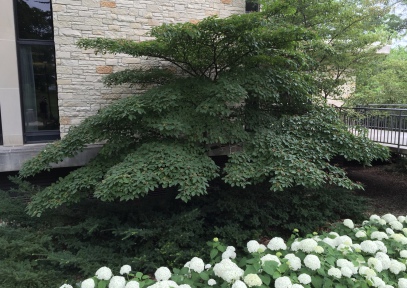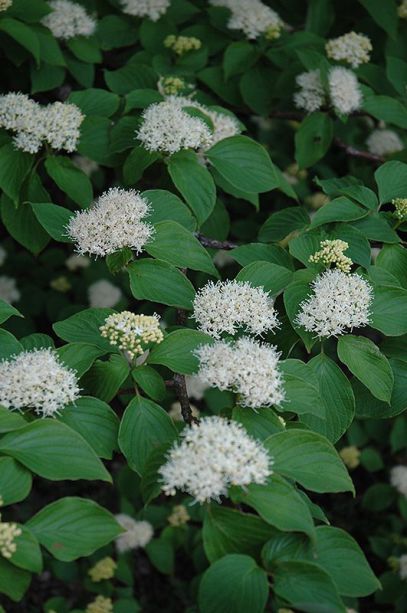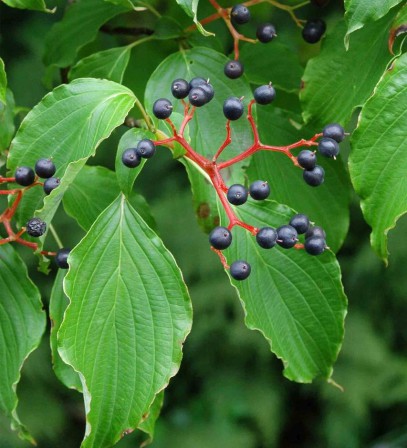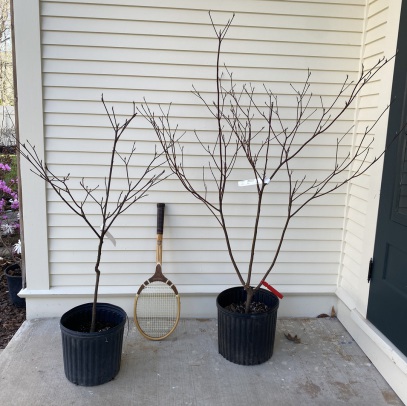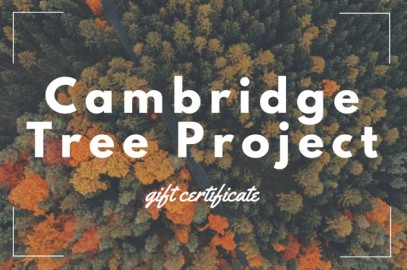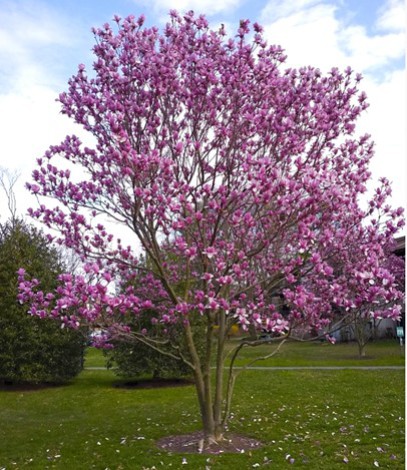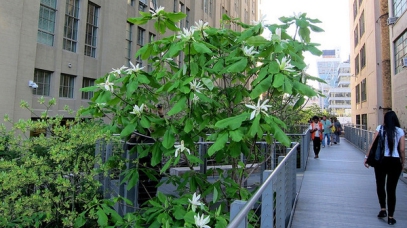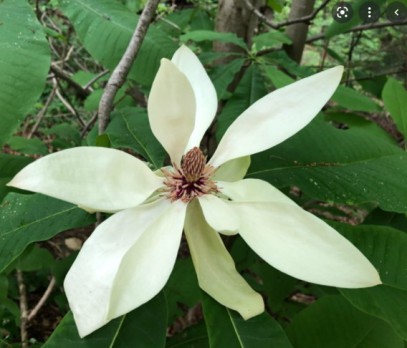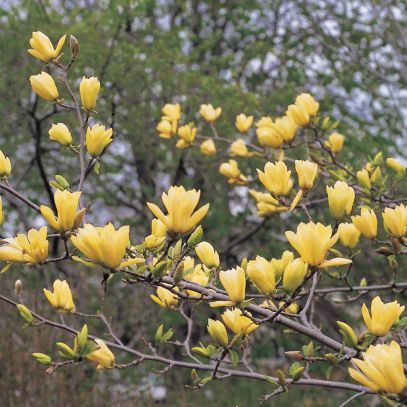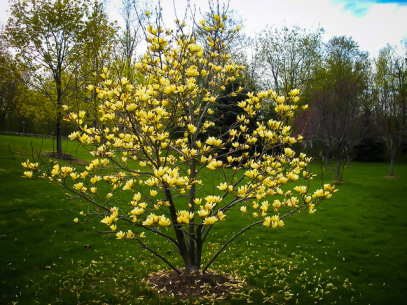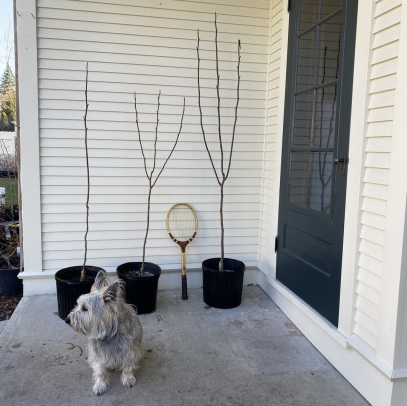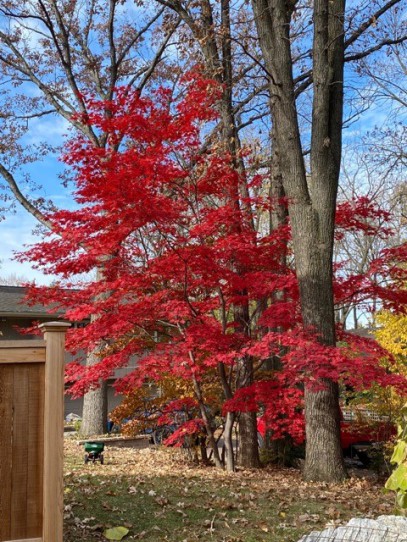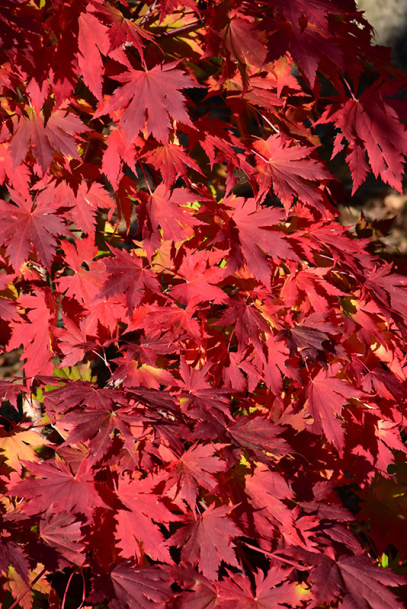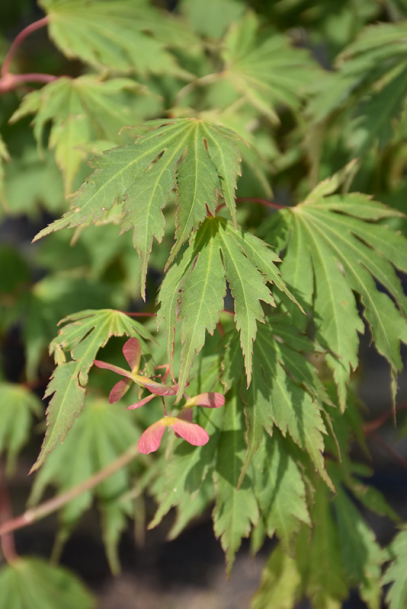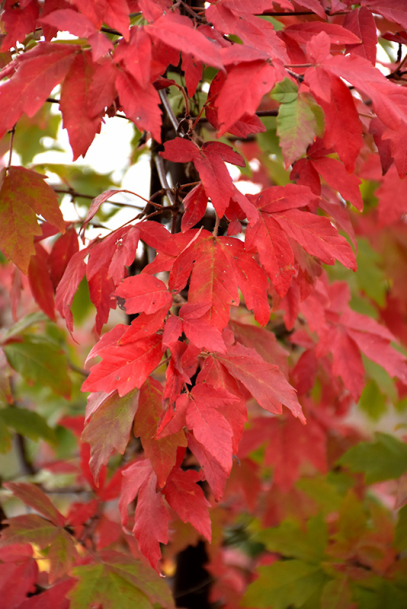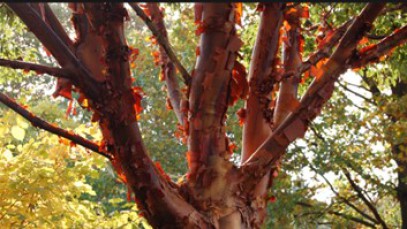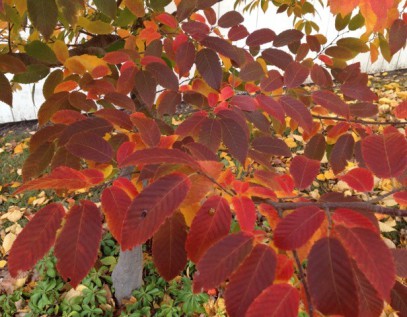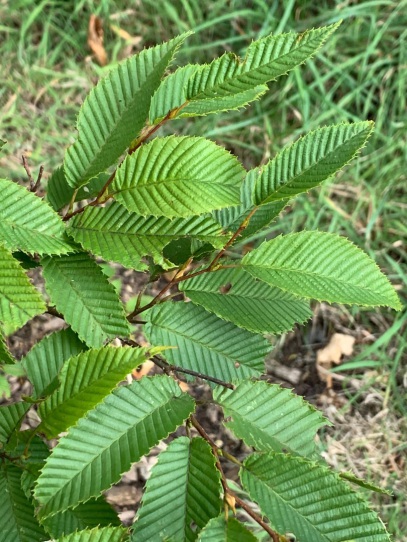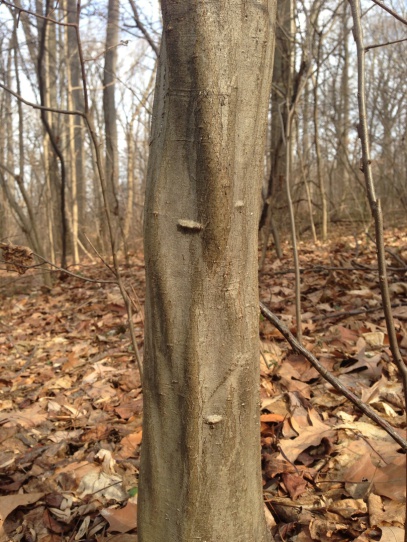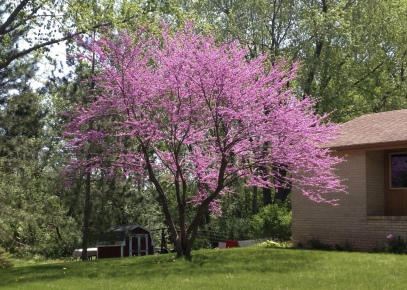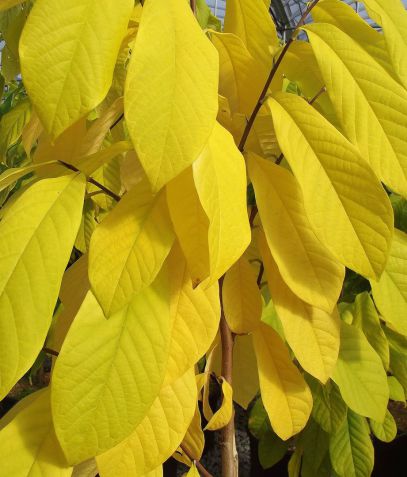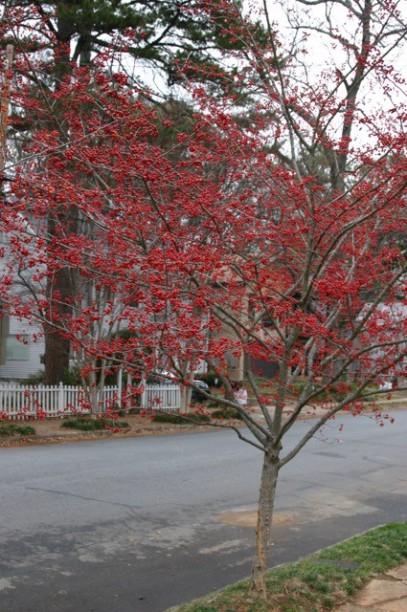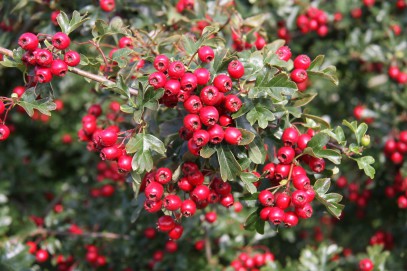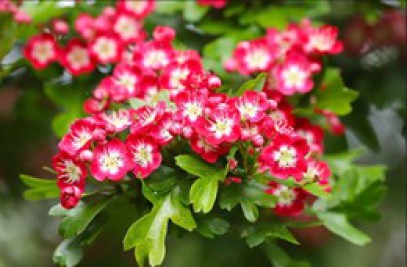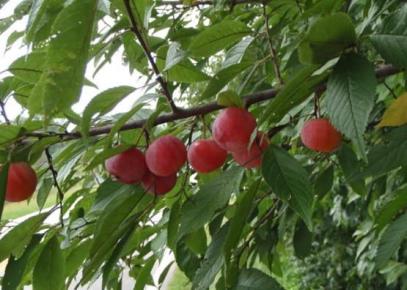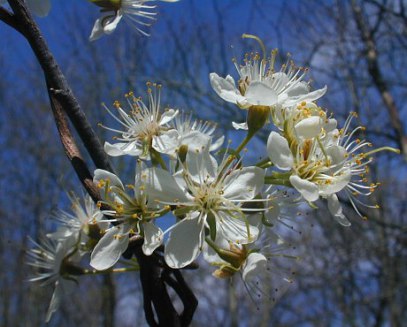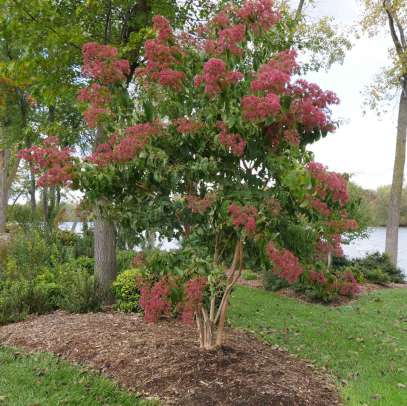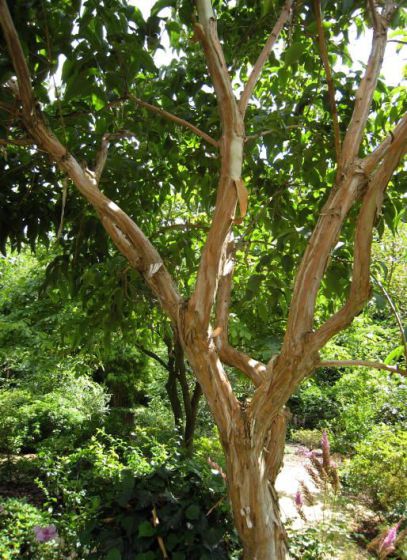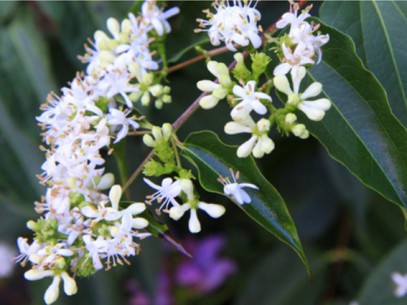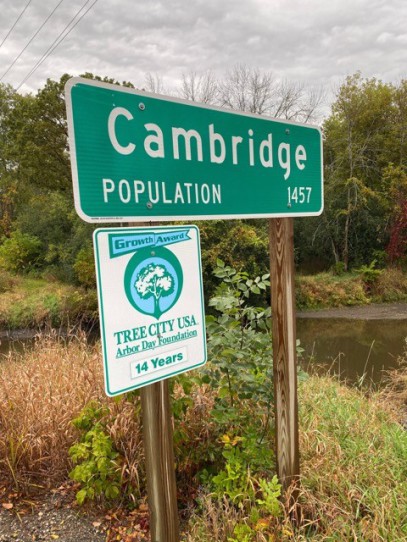
Ornamentals for Sale
Mature height generally less than 25 feet
Ornamentals delivered to your door (rates available by request) or schedule convenient curbside pickup in downtown Cambridge seven days weekly 8am-8pm.
Reserve your order by email or phone: info@cambridgetreeproject.org
608-513-1977
Dogwood, Pagoda
(Cornus alternifolia) Native
This charmer offers attractively tiered, horizontal branching and fragrant white flowers (see middle picture above) that bloom from late May into early June and arrive within several years of planting. Small dark blue fruits positioned on reddish purple stalks (pictured in middle, above) arrive in late summer and attract many species of backyard birds including blue jays. Pagoda dogwood also provides shelter and nesting habitat for many types of wildlife. Pagodas begin flowering and fruiting as young plants. Mature size is 15 ft. high and 10 ft. wide at a growth rate of 12 inches annually. Like most understory plants, pagodas prefer life in the shade: best landscape conditions include morning sun followed by afternoon shade.
3 ft. tall (tree form, potted) pictured above, at left: $60
4-5 ft. tall (shrub form, potted) pictured above, right: $75
Gift Certificates
- Birthdays, House Warmings!
- Email us for details: info@CambridgeTreeProject.org
Magnolias
Hardiness: Many people believe that magnolias aren't hardy in southern Wisconsin. Fortunately this is not the case! All of the following magnolias withstood -30F (air temperature, not wind chill) in late January 2019 during the polar vortex:
- 'Butterflies' (yellow flowering)
- 'Jane' (pink)
- Umbrella Magnolia
- 'Royal Star' (white)
- 'Galaxy' (pink)
- 'Leonard Messel' (light pink)
- Sweetbay Magnolia
- Saucer Magnolia
Culture: Magnolias perform best in deep, free-draining garden soil. Additionally, they're best located where there's shade in the afternoon given their stress response to heat. We recommend against planting magnolias in recently-developed subdivisions, where poor draining, compacted soils are commonly found.
Magnolia, Pink Flowering
(Magnolia x 'Galaxy') Deer Resistant
'Galaxy' is one of the largest pink flowering magnolias known, topping out up to 25 ft. tall with an upright, narrow tree form to 15 ft. wide. Its fragrant, rose-pink flowers are pictured immediately above. Our plants are single stem, tree form, but through selective pruning a multi-stem habit can be achieved.
NOTE: Magnolias require deep garden soil with good drainage and are not good choices for recently developed subdivisions where thin, compacted soils are commonly found.
5-6 ft. tall (potted): $95
Magnolia, Umbrella
(Magnolia tripetala) Deer Resistant
No hardy woody landscape plant matches the bold textural statement of an umbrella magnolia: leaves that reach two feet long and creamy white flowers to ten inches across (both pictured above). Ornamental deep red fruit clusters can reach up to four inches. A specimen at the UW Arboretum planted 60 years ago is over 30 ft. tall. Juvenile growth, however, is robust: 18-24 inches annually locally. Easy to grow in sun or heavy shade.
NOTE: Magnolias require deep garden soil with good drainage and are not good choices for recently developed subdivisions where thin, compacted soils are commonly found.
3 ft. tall seedling (potted): $65
5 ft. tall (potted): $75
Magnolia, Yellow Flowering
(Magnolia acuminata 'Butterflies') Deer Resistant
Nearly impossible to find locally, 'Butterflies' magnolia is one of our most requested trees given its beautiful yellow flowers and cold hardiness to -30F. Growth is slow (ten inches annually here in Cambridge) though this magnolia reaches 20 ft. tall and 15 ft. wide in pyramidal tree form. It can also be trained into a shrub form (see middle picture, above) through regular pruning. Flowers appear prior to leaf emergence for optimal impact.
NOTE: Magnolias require deep garden soil with good drainage and are not good choices for recently developed subdivisions where thin, compacted soils are commonly found.
4-5 ft. tall (seedling, potted): $65 (pictured above, left)
3-4 ft. tall (branched, potted): $80 (pictured above, middle)
4-5 ft. tall (branched, potted): $95
5 ft. tall (branched, potted): $105 (pictured above, right)
Maple, Japanese
'Northern Glow'
(Acer pseudosieboldianum x palmatum 'Hasselkus')
No Japanese maple has the cold powered moxie of 'Northern Glow'. Selected in Madison by Professor Emeritus Edward Hasselkus to easily withstand even our coldest winters. Its deeply lobed leaves are light green over summer months (pictured above) and turn brilliant red in fall (also shown above). Expect slower growth (six inches annually) to 20 ft. high and wide. Best located in sites with deep garden soil and afternoon shade.
4 ft. tall (multiple trunks, potted): $95
Maple, Paperbark
(Acer griseum)
Tree experts agree: paperbark maple offers the most impressive exfoliating bark of any tree hardy in our area (pictured immediately above). Additionally, it provides fall color that's unrivaled locally for its red intensity (also pictured at top, above). Growth rate is slow, our three trees in Cambridge are averaging only ten inches annually. Reaches 25 ft. high and 15 ft. wide, making it a perfect patio tree. Can be planted in full sun or a semi-shady location.
7 ft. tall (potted): $125
Special Order Ornamental Trees
We stock the following ornamental trees each spring and would be happy to reserve one for you.
info@cambridgetreeproject.org
608-513-1977
Musclewood
(Carpinus caroliniana 'Fire King') Native and Deer Resistant
Fine-textured understory tree with sinewy, smooth silver bark (see immediately above). A vibrant red fall color has been noted nearly every year locally (see at top, above) and the textured leaves look great over summer months (middle picture). Excellent choice for patios and in front of larger trees as it reaches only 30 ft. high and wide under most landscape conditions. Adapted to grow in sun or deep shade. We've recorded reasonably fast initial growth of ten younger musclewood trees planted throughout Cambridge, though the pace slows considerably after five years to average 14 inches annually over a decade. Native along rivers and streams and can be found on the main trail in CamRock Park along Koshkonong creek in Cambridge. 'Fire King' was selected in Wisconsin for reliably intense orange/red fall color, faster growth and improved, upright and compact form. Grows to 20 ft. tall by 15 ft. wide and is one of our longest-lived native ornamentals, reaching up to 150 years old.
Available fall 2024 by special order
Redbud, Eastern
(Cercis canadensis 'Minnesota Strain') Deer Resistant
Most redbuds won't survive the extreme cold of Madison's worst winters. Given this, we exclusively offer 'Minnesota Strain' - the hardiest cultivar available. Should you decide on a redbud, prepare for one of the most vivid spring flower shows in your neighborhood: a purple/pink spectacle that appears on all branches, not just the prior year’s growth like most flowering trees. Redbuds also offer attractive slate grey and reddish mottled bark and heart shaped leaves which emerge a reddish purple and can turn a warm yellow in fall. Redbuds grow to 20 ft. high at a rate of 14 inches annually locally, based on measurements of 21 trees planted throughout Cambridge.
Available spring 2025 by special order
Cherry, Pink Flowering
(Prunus sargentii x 'Spring Wonder')
While most flowering cherries aren't fully hardy in the Madison area, we offer 'Spring Wonder,' a Sargent Cherry selection that readily withstands even our coldest winters. Expect a stunning display of pink flowers in early spring, just prior to leaf emergence for optimal impact (see top pictures above). 'Spring Wonder' is also noted for its attractive vase shaped form (see top photo above) and compact size: maturing to only 25 ft. tall and 20 ft. wide. Additional attractions include polished mahogany bark (pictured immediately above) and shiny dark green foliage that turns bronze to brick red in fall. This tree hasn't produced fruit in early nursery and arboretum trials. Grows at an average rate: about 18 inches annually.
Available spring 2025 by special order
Dogwood, Yellow Flowering
(Cornus mas 'Golden Glory')
The first tree to flower locally, presenting a welcome burst of yellow as early as mid-March (see top picture, above). Beautifully exfoliating bark (pictured immediately above) provides four season appeal. Dark green leaves are resistant to insect damage and turn wine red in fall most years. Ornamental red fruit (pictured above, middle) is commonly used in Eastern and Southern Europe for jams and jellies. Easy to grow in any soil that isn't waterlogged, in sun or in shade. Growth is very slow, only six inches annually on the 11 trees growing throughout Cambridge. Flowers arrive early, only a year or two after planting, and this tree fruits early as well, within 5-10 years. 200-year-old specimens in Kiev are still fruiting. We offer 'Golden Glory,' an improved cultivar featuring faster growth, more prolific flowering, and an upright tree form. Reaches 20 ft. tall and 15 ft. wide.
Available spring 2025 by special order
Pawpaw
(Asimina triloba) Deer Resistant
We offer pawpaws sourced from the northern extreme of their native range; these trees have withstood -32F (no wind) along Koshkonong Creek in the CamRock park system in Cambridge with no cold injury. The exceptional buttery yellow fall leaf color (see picture immediately above, taken at the UW Arboretum) on larger, droopy, and tropical looking leaves makes quite a landscape impression in fall. Edible, flavorful, and highly nutritious fruit also appears in fall. Will reach 15-20 ft. high and wide. A pawpaw planted near Nikolay School on South Street in Cambridge is growing 12 inches annually. Nearly native, it grows across the lake in lower Michigan in the forest understory.
NOTE: at least two paw paws are required to assure cross pollination to yield a fruit set.
Available fall 2024 by special order
8-24" tall seedling (potted): $38
Hawthorn, Scarlet
(Crataegus laevigata 'Crimson Cloud') Deer Resistant
This hawthorn travels in the elite class of flowering trees: its unique red flowers (with an interior splash of white, pictured immediately above) are considered the showiest of all hawthorns. Also features petite bright red berries that offer needed color over winter months (top photo above) and provide food for birds. Deeply lobed dark green leaves (see pics above) have no fall color but are resistant to leaf blights that commonly impact other hawthorns and crabtrees during wet weather. Unlike most hawthorns, 'Crimson Cloud' has very few thorns. Hawthorns are longer lived than crabtrees and redbuds, commonly reaching 100 years and older. Easy to grow in all soil types with good drainage. Prefers a sunny location. Growth is 18 inches annually on juvenile trees. Reaches 25 ft. high and 15 ft. wide.
Available spring 2025 by special order
Hawthorn, White Flowering
(Crataegus viridis 'Winter King') Deer Resistant
A superior ornamental with four season appeal: tan and silver exfoliating bark (pictured immediately above); vividly attractive, persistent orange/red berries (shown at top and bottom, above) and white flowers in spring (middle picture, above). 'Winter King' has thorns which are known to help protect bird populations against predation. Grows to 20 ft. high and wide at a rate of 18 inches locally on juvenile trees. Hawthorns are longer lived than crabtrees and redbuds, commonly reaching 100 years and older. Leaves and fruit are resistant to the unsightly blights that affect so many crabtrees in our climate.
Available spring 2025 by special order
Magnolia, White Flowering
(Magnolia stellata 'Royal Star') Deer Resistant
'Royal Star' offers a reliable burst of fragrant white flowers every spring. And, they begin flowering when only several feet tall, so there's no waiting around! Clean dark green foliage looks great all summer. One of the few magnolias known to be tolerant of heat. Flowers best in full sun but will tolerate light shade. Can be trained into tree or shrub form, based on pruning. Matures to 15 ft. high and 12 ft. wide.
NOTE: Magnolias require deep garden soil with good drainage and are not good choices for recently developed subdivisions where thin, compacted soils are commonly found.
Available fall 2024 by special order
Ironwood
(Ostrya virginiana) Native and Deer Resistant
A common smaller understory tree that can be introduced as a graceful element to your home landscape. Will grow in deep shade or full sun, making it one of our more versatile natives. Also tolerates heat, drought and thin, rocky soils. Interesting features include hop-type fruits (pictured at top, above) and flaking, irregular bark (shown immediately above). Wood is extremely hard and was used for tool handles in frontier times. We've recorded surprisingly robust initial growth of the 13 ironwoods planted throughout Cambridge: 20 inches annually, though this rate will slow considerably over time to average one ft. annually. Reaches 25 ft. tall and 20 ft. wide in cultivation and is long-lived, reaching up to 150 years.
Available spring 2025 by special order
Plum, American
(Prunus americana) Native
A common component of woodlands locally. Attractive clear white flowers (pictured at top, above) arrive prior to leaf emergence for optimal impact. Plums (see middle picture, above) arrive in July and are used for jellies and jams and can be eaten raw, but sweetness and flavor are variable. Not every American plum is self-fertile, so two trees are suggested to guaranty and optimize a fruit set, which arrives three to six years after planting. This is a tenacious tree that will thrive virtually anywhere except water-logged soils. Adventurous saplings are produced by some trees from underground roots that can be mowed over or clipped unless a screen is desired. Some American plums have thorns, and most have short spurs. Reaches 15 to 25 feet tall and wide at a rate of 18-30" annually as a juvenile tree.
NOTE: We recommend purchasing two American plums to assure cross pollination to yield a fruit set.
Available fall 2024 by special order
Seven Son Flower
(Heptacodium miconoides 'Tianshan')
As close as one can get to the appeal of a crape myrtle in our climate. This small tree or shrub has it all: attractive exfoliating bark in brown, gray and tan; sweetly fragrant creamy white flowers in late summer (when little else is flowering); and ornamental rose purple-colored fruits in fall (all pictured immediately above). Requires excellent drainage and is drought tolerant. We offer an improved cultivar ('Tianshan') which is more compact than the species, reaching only 12 ft. tall and 7 ft. wide at maturity. It also has a fuller, more evenly branched form and glossy dark green foliage.
Available spring 2025 by special order
Proceeds from our non-profit tree sales have gifted and established over 1000 additional living trees in Cambridge since 2006
